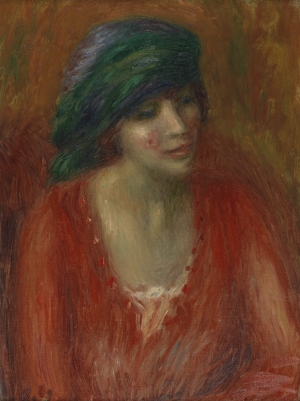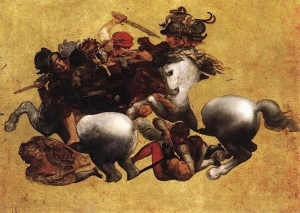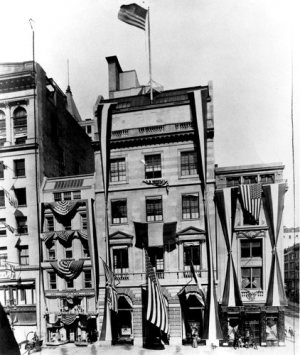|
Displaying items by tag: scholars

A painting by the 17th century Flemish Baroque artist, Anthony van Dyck (1599-1641), was discovered in a storage room belonging to the Bowes Museum in England. Portrait of Olive Boteler Porter was purchased by the Bowes Museum’s founders, John and Josephine Bowes, in 1866 and has been in the institution’s collection since it opened to the public in 1892.
The painting’s poor condition led museum officials to record it in files as ‘School of van Dyck’ rather than an original van Dyck masterpiece. Relegated to a storage room, the work was discovered when it was photographed earlier this year for a project committed to putting all of the UK’s publically owned oil paintings on a single website. Art historian and dealer, Dr. Bendor Grosvenor, who is working on the digital venture, recognized the wrongly identified painting as an original Van Dyck.
The oil on canvas painting features the expert drapery and coloring often present in van Dyck’s female portraits from the 1630s. Originally thought to be a painting of Queen Henrietta Maria, additional research identified the sitter as Olive Boteler Porter, the queen’s lady-in-waiting and the wife of van Dyck’s friend and patron Endymion Porter.
After being examined by various van Dyck scholars, the painting has been authenticated. The recently restored masterpiece is now on view at the Bowes Museum.

In 2006 The Cardsharps was sold to the late collector and scholar Sir Denis Mahon for just over $65,000 at an auction at Sotheby’s in London. At the time of the sale, Sotheby’s identified the work as being by a “follower” of the Italian master, Caravaggio (1571-1610). However, after his purchase, Mahon identified the work as a Caravaggio original and obtained an export license for the work that put its value at $15.5 million according to a claim filed at London’s High Court of Justice.
Due to their failure to identify The Cardsharps as an authentic Caravaggio painting, Sotheby’s is being sued by Lancelot William Thwaytes, who consigned the work to the 2006 auction. Thwaytes is now seeking unspecified damages, interest, and costs relating to the price difference between the painting’s 2006 selling price and what he believes it was actually worth on the open market that year had it been properly attributed to Caravaggio. Thwaytes claims that Sotheby’s was negligent in its research prior to the work’s sale, leading to its extraordinarily low selling price.
However, Sotheby’s stands behind its belief that the painting is a copy and not a work by Caravaggio’s hand, citing Caravaggio expert Professor Richard Spear and several other leading scholars. Sotheby’s added that their view was supported by the market’s reception to the painting when it was put up for auction.
Mahon, who passed away in 2011, donated 58 works from his collection worth around $155 million to various U.K. galleries.

A painting by the Italian master Tiziano Vecellio (circa 1488/1490-1576), who is known in English as Titian, was recently discovered in London’s National Gallery. Located in Trafalgar Square, the museum houses the country’s collection of Western European paintings from the 13th to 19th centuries.
The portrait by Titian, a pivotal member of the 16th century Venetian school of painters, depicts Girolamo Fracastoro, a well-respected doctor at the time, draped in lynx fur. The National Gallery has owned the portrait of Fracastoro since 1924 but until recently attribution has been uncertain. The Fracastoro portrait underwent thorough restoration, revealing new information about the canvas and technique, prompting scholars and curators to uphold the attribution.
The painting is now being displayed as part of the National Gallery’s main collection. The portrait of Fracastoro is the third Titian painting to join the museum’s holdings since 2009 making the National Gallery’s Titian collection one of the finest in the world.

The Pennsylvania Academy of the Fine Arts (PAFA) in Philadelphia announced plans to build a new gallery to display their works on paper collection. The addition will be housed in the museum’s Historic Landmark Building, which was designed by the acclaimed American architect, Frank Furness (1839-1912). A $250,000 grant from The Richard C. von Hess Foundation will be used to fund the project.
Works on paper are a huge component of PAFA’s permanent collection, encompassing over 75% of the museum’s holdings. The collection features drawings, watercolors, sketchbooks, prints, photographs, and experimental media from all periods of American art. Highlights include a collection of photographs by Thomas Eakins (1844-1916), studies and sketchbooks by William Glackens (1870-1938), and works by John Singleton Copley (1738-1815), Mary Cassatt (1844-1926), Arthur Dove (1880-1946), and Robert Motherwell (1915-1991).
The new gallery will allow the institution to significantly expand public access to its vast collection while keeping the light-sensitive objects safe. A separate space will be allotted for scholars conducting research and curators and faculty who will use the collection for educational purposes. PAFA has selected the Philadelphia-based architectural firm Atkin Olshin Schade to design the Works on Paper Gallery. Construction is expected to start early this year and last until Summer 2013.

Mary Griggs Burke, who built the most comprehensive collection of Japanese art outside of Japan, passed away on December 8, 2012 at her home in Manhattan. She was 96.
Burke’s collection, which she amassed over fifty years, featured thousands of artifacts including paintings, prints, sculpture, textiles, lacquerware, ceramics, and calligraphy. Worth tens of millions of dollars, her meticulously assembled collection spans five millenniums and includes early pieces from around 3000 B.C. to works of the 19th century A.D.
Burke was born in St. Paul, Minnesota in 1916, where she grew up in a Victorian mansion adorned with 18th century French objets d’art as well as a few important Japanese artifacts. After earning a bachelor’s degree in 1938 from Sarah Lawrence College and a master’s in clinical psychology from Columbia, Burke traveled to Japan in 1954. Japanese-influenced Bauhaus architect, Walter Gropius, who was designing a house for Burke, suggested the visit. Burke immediately fell in love with Japan and its art and returned to the country dozens of times throughout her life.
Burke began avidly collecting Japanese art in 1963. Her holdings eventually grew so vast that they required their own residence. Burke purchased the apartment adjacent to her own on the Upper East Side of Manhattan to house her collection; she also employed a curatorial staff and encouraged students and scholars to visit. In 2006, Burke announced that after her death her collection would be divided between the Metropolitan Museum of Art in New York and the Minneapolis Institute of Art. Burke served on the boards of many institutions, including the Met. At the time of her death she was an emeritus trustee of the museum.

On view through April 12, 2013 at the Cleveland Museum of Art, Picasso and the Mysteries of Life: Deconstructing La Vie is the first exhibition devoted to Pablo Picasso’s (1881-1973) complex masterpiece, which defined his well-known Blue Period. A cornerstone of the museum’s collection, La Vie (1903) is accompanied by related works on loan from Barcelona’s Museu Picasso as well as works by Francisco Goya (1746-1828), Albrecht Dürer (1471-1528), and Auguste Rodin (1840-1917) from the Cleveland Museum’s own collection.
The exhibition uses x-radiographs, infrared reflectographs, and other scientific methods to delve into the process behind La Vie. Displayed on iPads, the technological investigation illustrates Picasso’s creative process and how he altered the painting’s composition considerably before deeming the work complete.
Picasso drew preliminary sketches for La Vie in May of 1903. At the time, he was a young, unknown artist who still lived in his parents’ home in Barcelona. The first sketches depicted an artist in his studio and evolved into a more intricate scene meant to evoke thoughts about life and art and the intersection of the two. A solid analysis of La Vie has always eluded scholars due to its enigmatic subject, early history, and its relationship to Picasso’s other works from this time. However, the painting has never been examined as thoroughly and in-depth as by the Cleveland Museum of Art.
Picasso and the Mysteries of Life strives to make sense of the work by exploring the subjects of the painting. Carles Casagemas, the gaunt man featured in the work’s left foreground, was a friend of Picasso’s and a fellow artist. Casagemas committed suicide in 1901, prompting Picasso to contemplate the glorification of suicide and the bohemian lifestyle in modern art and culture. The woman standing behind Casagemas in La Vie has been identified as Germaine Pichot, his lover and a contributor to his suicide. Pichot stands as a symbol of Picasso’s coded representation of women and in a broader sense, as the fatal woman often portrayed in modern art.
A 163-page book by William H. Robinson, the Cleveland Museum’s curator of modern European art, accompanies the exhibition. The book further explores the role of La Vie in Picasso’s creative process as well as the important issues in the modernist culture of the 19th and 20th centuries that affected Picasso and his work. Robinson explores how Spanish and French literature affected Picasso’s Blue Period paintings, the impact of Rodin’s large retrospective of 1900 on the young artist, and Picasso’s ongoing struggle to fully understand the notions of fate and destiny.
Deconstructing La Vie is the inaugural exhibition in the Cleveland Museum of Art’s new Focus Gallery.

A division of the Italian police department that specializes in art thefts has located a 400-year-old copy of a lost Leonardo da Vinci fresco. Depicting the Battle of Anghiari, the masterpiece was never finished.
The copy, widely known as the Tavola Doria, once adorned a wall of Florence’s city hall, the Palazzo Vecchio, and illustrates a historic battle between Florence and Milan that took place in 1440. It is believed that da Vinci experimented with various fresco-painting techniques before he started work on the battle scene in 1503. Despite his efforts, the paints began to drip and da Vinci was never able to finish the fresco. Over the next few years, the piece deteriorated and the Italian painter, Giorgio Vasari, was commissioned to paint over what was left of the incomplete fresco.
Since the unfinished da Vinci painting no longer exists, copies of the lost artwork are extremely important to art historians and scholars. This particular copy, painted on a small wooden panel, was last seen in public 73 years ago at a Leonardo da Vinci exhibition held in Milan on the eve of World War II. After the exhibition, the work disappeared.
Experts have since determined that the panel was stolen from its owners in Naples and ended up in the hands of a Swiss art dealer. The work was sent to Germany for restoration in the 1960s, made a brief appearance in the 1970s at an art gallery in New York, and by the 1990s was the property of a wealthy Japanese art collector.
Finally back in Italy, the Tavola Doria will be on view at Florence’s Uffizi Gallery during 2013. The work will then spend four years in Japan as part of a loan agreement worked out with the Fuji Art Museum in Tokyo, where it was last exhibited.

Picasso Black and White opened earlier this month at the Guggenheim Museum in New York. The first major exhibition to focus on the artist’s lifelong exploration of a black and white palette features 118 painting, sculptures, and works on paper spanning from 1904 to 1971. Five of the works have never been exhibited or published and another thirty-eight works have never been on view in the U.S.
The Guggenheim exhibition has received plenty of praise since its opening but there is one painting in the show that is unlike the others. Woman Ironing (La Repasseuse) is a quintessential image of the disenfranchised people Picasso focused on during his Blue Period (1901–1904). Painted at the tail end of the period, the white and gray palette creates a tired, bleak atmosphere for the frail woman who stands hunched over her iron. But there is something beyond this gloomy woman.
Picasso painted Woman Ironing while he was a struggling artist in his 20s. For economy’s sake he reused an old canvas that he had already used for the beginnings of a portrait of man with a mustache, which he later abandoned. In 1989 an infrared camera detected the presence of the man underneath Woman Ironing. Advances in x-ray and infrared technology have allowed a clearer image of the mysterious mustachioed man and scholars, curators, and conservators have various theories as to who he is. Suggestions include Richard Canals, a rival artist and friend of Picasso, Mateu de Soto, a sculptor with whom Picasso shared apartments and studios with, and Benet Soler, a tailor who was one of Picasso’s oldest friends. Some theories suggest the man with the mustache was one of Picasso’s early self-portraits.
Black and White and Woman Ironing will be on view at the Guggenheim through January 23, 2013.

165 years ago, the Knoedler Gallery opened its doors in New York and went on to help create some of the country’s most celebrated collections including those of Paul Mellon, Henry Clay Frick, and Robert Sterling Clark. Throughout the years, top-notch works by artists such as van Gogh, Manet, Winslow Homer, John Singer Sargent, Louise Bourgeois, and Willem de Kooning passed through the gallery. When the Soviet government sold hundreds of paintings from the State Hermitage Museum in Leningrad in the 1930s, they chose to work with Knoedler to sell paintings by masters like Rembrandt, Raphael, and Velazquez.
Knoedler’s exemplary past is often forgotten as the gallery’s present has been mired in lawsuits and accusations that the company’s former president, Ann Freedman, was in the business of selling fakes. Last year, Knoedler Gallery closed its doors for good.
This week, Los Angeles’ Getty Research Institute announced that it had bought the Knoedler Gallery archive. Spanning from around 1850 to 1971, the archive includes stock books, sales books, a photo archive and files of correspondence, including letters from artists and collectors, some with illustrations. The Getty was interested in Knoedler’s archive because it offers an expansive glimpse into the history of collecting and the art market in the United States and Europe from the mid-19th century to modern times.
The archive was purchased from Knoedler’s owner, Michael Hammer, for an undisclosed amount. Meticulously preserved, the archive will be available to scholars and digitized for online research after the Getty catalogues and conserves it all.
|
|
|
|
|